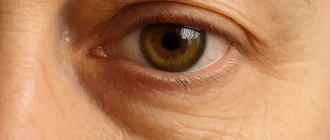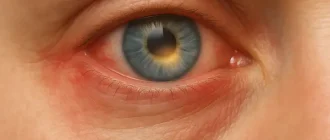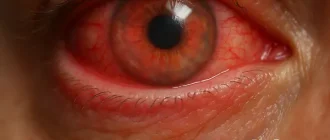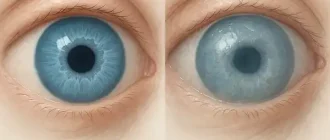Conjunctivitis is a common eye disease, especially in children, but it cannot be called a dangerous condition. Often, after some time, it goes away on its own, without treatment.
Conjunctivitis is an inflammation of the mucous membrane of the eye (conjunctiva), which covers the inside of the eyelids as well as the protein part of the eyeball – the sclera.
But in some cases, it can develop into more serious problems with the eyes. Some forms of conjunctivitis are very contagious and can cause outbreaks in the community (for example, in kindergartens or schools).
Conjunctivitis Symptoms
Symptoms and complaints of conjunctivitis:
- Redness of the conjunctiva and eyelids;
- Edema of the conjunctiva and eyelids;
- Pain, itching, burning in the eyes;
- lacrimation;
- photosensitivity;
- Eye discharge (mucous, purulent).
Conjunctivitis may affect one or both eyes.
Types of Conjunctivitis
There are 2 main types of conjunctivitis:
- Infectious (viral and bacterial, less often chlamydial and fungal);
- Allergic (develops upon contact with the substance causing an allergic reaction).
According to the form of the course of the disease are distinguished:
- acute conjunctivitis;
- chronic conjunctivitis.
Bacterial conjunctivitis is most commonly caused by staphylococcal and streptococcal bacteria. In addition to the above symptoms and complaints, a characteristic feature of bacterial conjunctivitis is a purulent discharge from the affected eye.
Viral conjunctivitis most commonly occurs due to the effect of adenoviruses on the mucosa (less often herpes virus, etc.). The main symptoms of viral conjunctivitis are redness and irritation of the eyes, and intense lacrimation. They are often accompanied by general malaise, weakness, fever, cough, runny nose, headaches. A differentiation is made between catarrhal (the most common form, the most favourable course, causes no complications), follicular (follicles and small haemorrhages are formed on the mucosa) and membranous forms (more severe course, occurs rarely, grayish-white films are formed on the mucosa, upon removal of which the mucosa may bleed with subsequent scarring in places of their removal). Viral conjunctivitis is not associated with purulent discharge from the eye. However, there may be a secondary bacterial infection of the already existing viral process in the eye.
Allergic conjunctivitis develops from contact with an allergen. The allergen can be any plant (spring pollinosis), house dust, food, animal hair and fur, hygiene products, household chemicals, decorative cosmetics, medications and much, much more. Characteristic of allergic conjunctivitis, in addition to the general signs, is severe itching of the mucosa of the eyeball and eyelids.
Diagnosing Conjunctivitis
The diagnosis of conjunctivitis is carried out according to the following scheme:
- interviewing the patient (clarification of complaints, time and circumstances of their occurrence, exclusion of contact with a person who already has similar eye complaints, or contact with a possible allergen, assessment of general well-being, etc.)
- examination of visual acuity;
- examination of the anterior segment of the eye (examination of the conjunctiva, cornea, assessment of the moisture of the anterior chamber of the eye, the condition of the iris, and the lens);
- Examination of the underlying structures (to rule out the involvement of the underlying parts of the eye in the inflammatory process).
As additional diagnostic methods, conjunctival cultures of the affected eye may be examined (smears may be taken) for identification of the pathogen. This procedure is most often required in cases of no effect of the ongoing treatment, or in the chronic course of conjunctivitis. The necessity and appropriateness of conjunctival smears is evaluated by the treating physician in each case.
Conjunctivitis Treatment
The treatment of conjunctivitis is based on determining the cause. Depending on the cause, the treatment strategy is determined.
Most conjunctivitis resolves itself and does not require any special treatment.
In cases of bacterial conjunctivitis with small pus-like discharge from the eyes, it is necessary to frequently flush/clean the eyes with saline solution several times a day. In case of increasing inflammation and complaints over the next few days the doctor should be consulted.
Treating pink eye usually needs liberal use of over-the-counter eye drops formulated especially for conjunctivitis symptoms.
Chicago Tribune
In cases of viral conjunctivitis there is no treatment at all (except for rare herpes-associated conjunctivitis) due to the lack of specific antiviral drugs (effectiveness of the antiviral drug Oftalmoferon has no serious evidence; apart from Russia, it is not used anywhere else). As with a cold, viral conjunctivitis is curable on its own. The only possible treatment is symptomatic therapy to alleviate the suffering of the patient for the period of inflammation – cool compresses, artificial lacrimation. In the case of a severe course of conjunctivitis, you should also consult a doctor.
Prevention Measures
Viral conjunctivitis is highly contagious. If somebody in your house has the viral variety of the disease and touches a surface such as a doorknob, the infection can live on that surface for numerous weeks.
Bacterial conjunctivitis, while contagious, does not spread out as quickly, he says. Stay home for as long as the eyes are red and watering, accorsing to WSJ.
Make sure to dispose of any tissues used immediately. Ensure whoever is impacted isn’t sharing towels or pillows — or anything that comes into contact with the eyes or hands. And once your home is rid of disease, sanitize significant surface areas and wash sheets and towels. Computer systems are an unexpected location where infections can stick around, so ensure to wipe down your keyboard.





